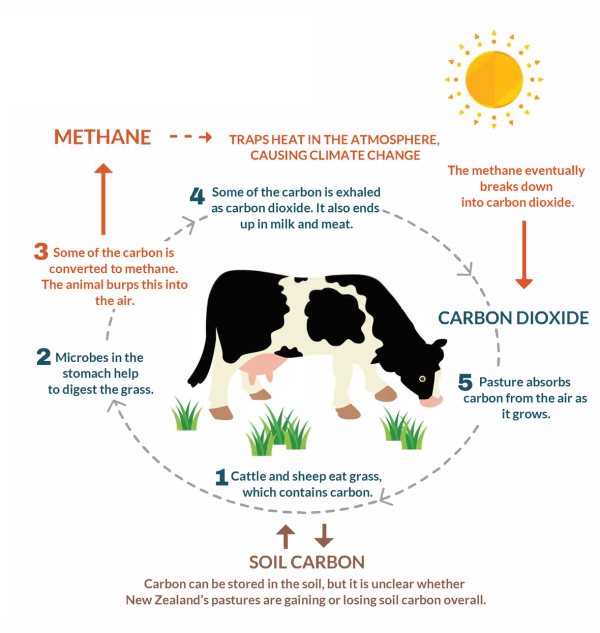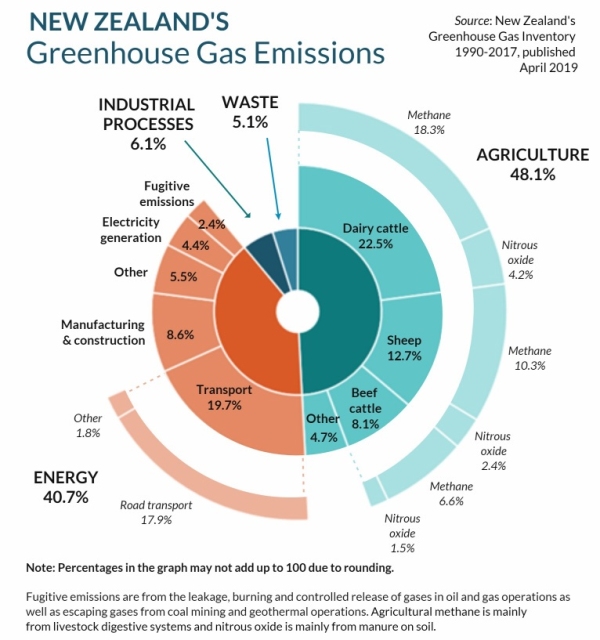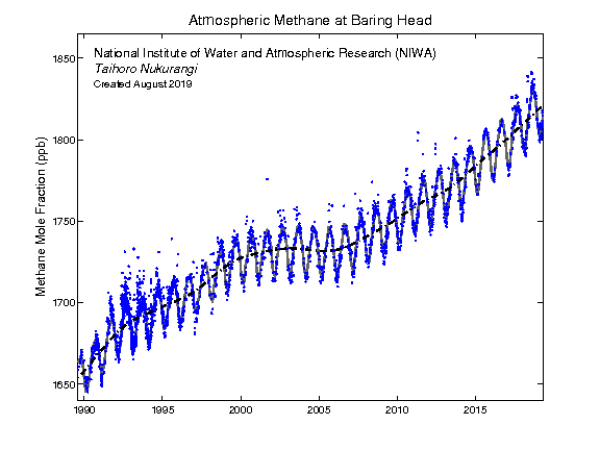On this page:
- Greenhouse gas emissions from agriculture
- Methane (CH4)
- The problem with methane
- Measuring methane
- Methane and the Climate Change Response (Zero Carbon) Amendment Act
- Mitigation by farmers
- Researching new options to reduce emissions
Greenhouse gas emissions from agriculture
Almost half of New Zealand’s greenhouse gas emissions come from agriculture. Methane (CH4) and nitrous oxide (N2O) are the two main agricultural greenhouse gases.
Methane makes up the majority of these emissions and comes from farmed livestock, such as sheep and cattle.
These animals naturally produce methane as a by-product of their digestive process and release it into the air – primarily through burping.
Nitrous oxide is produced when nitrogen compounds in urine, manure and fertilisers are broken down by microbes in the soil and released into the atmosphere.
Methane (CH4)
Methane (CH4) occurs naturally in the environment as well as being released through human activities. It is the second most important greenhouse gas after carbon dioxide (CO2) that is produced by human activities.
While most manmade CO2 emissions come from industrial processes, such as fossil fuel burning, the majority of human-induced CH4 emissions come from agriculture (from livestock, rice cultivation and biomass burning – such as clearing land by burning vegetation).
Fossil fuel sources are also the second most important manmade source of methane to the atmosphere.
You might also like to check out the Ministry for the Environment’s interactive greenhouse gas emissions tracker.
The problem with methane
Methane is known as a short-lived gas because it only remains in the atmosphere for around 12 years before breaking down. In contrast, CO2 is a long-lived gas that can remain in the atmosphere for centuries.
These different effects of greenhouse gases on the atmosphere are described as their ‘global warming potential'.
Despite being short-lived, methane is around 30 times more effective at trapping heat in the atmosphere than CO2, making methane a powerful greenhouse gas. Releasing one tonne of methane into the atmosphere would create the same amount of warming as 30 tonnes of CO2 over 100 years.
Read more about the Global Warming Potentials of greenhouse gases.
As the human population has grown, the number of farmed animals has increased significantly to meet the demand for food through meat and dairy products, as well as other products such as leather and wool fibre. In turn, atmospheric methane levels have noticeably increased over this period. In fact, it is estimated atmospheric methane levels have risen by more than 150 percent since the 1700s.
Measuring methane
NIWA has been measuring the concentrations of methane in the atmosphere at its atmospheric monitoring site at Baring Head near Wellington since 1989.
The graph shows the rise of atmospheric methane since this time.
Read more about the work being done monitoring greenhouse gas levels.
Measuring agricultural emissions
Several techniques have been developed to measure greenhouse gas emissions from agriculture.
Some of these include:
- Respiration chambers – animals are contained within a chamber to measure the amount of methane they are producing.
- Soil chambers – samples of air from patches of soil can be collected to measure nitrous oxide.
- SF6 tracer technique – animals are fitted with equipment that measures emissions while the animal is grazing freely in a paddock.
- Paddock-scale micro-meteorological techniques – used to calculate greenhouse gas emissions from all livestock in a paddock. This can be used for both methane and nitrous oxide.
- Regional atmospheric inverse modelling, where whole regions emissions of CO2 or CH4 can be quantified from a network of concentration measuring stations.
Methane and the Climate Change Response (Zero Carbon) Amendment Act
The Climate Change Response (Zero Carbon) Amendment Act puts in place targets to reduce net emissions of greenhouse gases to zero by 2050.
However the Act treats methane produced from biological sources (known as biogenic) separately. Under the Act, New Zealand must reduce methane emissions from biological sources – i.e. agriculture – by 10% by 2030, and within the range of 24-47% reduction by 2050.
Read more about the Climate Change Response (Zero Carbon) Amendment Act.
Mitigation by farmers
Many farmers have already begun to make changes to the way they farm to help lower agricultural greenhouse gas emissions, alongside efforts to adapt to the changing climate. Most of the ways these emissions can be reduced come down to having good farming practices in place to farm more efficiently. Options to reduce emissions can include:
Feed management
The more an animal eats, the more greenhouse gases it produces. Controlling how much and what type of feed livestock eat can help to reduce emissions. Different plant types have different impacts on the amount of methane produced by an animal due to the different chemical makeup of each plant type.
Ongoing research is looking into low-emitting feed types to explore the best options to help lower emissions.
Reducing nitrogen use and loss
Applying nitrogen-based fertilisers leads to nitrogen leaching and increased nitrous oxide emissions. Options to reduce nitrous oxide emissions can include: better fertiliser application and planting low-nitrogen crops. Small reductions in production intensity can reduce environmental impact while still maintaining profitability.
Planting trees
Planting trees can help farmers to offset their greenhouse gas emissions. Trees store carbon as they grow and in doing so remove it from the atmosphere.
Read more about what farmers can do to reduce emissions.
Researching new options to reduce emissions
Lots of research is being done to find new options to help reduce agricultural greenhouse gas emissions. For instance, researchers are exploring:
- breeding low-emitting animals
- planting low-emitting crops and using low-emitting feed additives
- methane vaccination to reduce methane production
- methane inhibitors to suppress the methane producing microbes in an animal’s gut.
- Alternative manure management treatments to capture or reduce methane from effluent.
Read about research currently underway by the NZ Agricultural Greenhouse Gas Research Centre.



